Walther’s MP5 SD6 is a plinking classic that mimics the suppressed MP5 SD3. Look no further if you’re looking for some .22lr fun in a tacticool package reminiscent of 90s action movies.
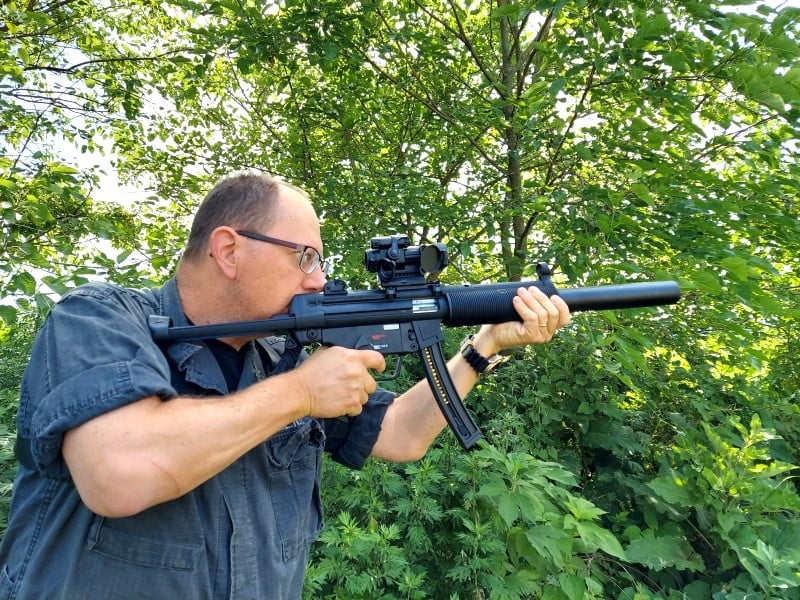
But First Some Walther History
In 1886, Carl Wilhelm Freund Walther started his own business of rifle making, where he began making hunting and target shooting rifles. He was 28 at the time and had very little in the way of tools or equipment with which to ply his trade. Carl’s wife had a manufacturing background, and three of their five sons learned how to make rifles at their parents’ company. In 1903, they built a small factory in Zella-Mehlis.
From 1908 until 1921, they produced semi-automatic pistols. In 1921, they introduced a self-loading shotgun, and then in 1932, they designed a double-barrel shotgun and small-bore rifles. Carl’s son, Fritz, took over the company in 1915 after his father’s death. His brothers remained with the company as well.
In the 1920s, Walther began producing calculators, which made their way to being used around the world. In 1929, the Walther PP was born, followed by the PPK (a compact version) in 1931. Versions of these pistols are still produced today.

During WWII, Walther introduced the P38 pistol, which replaced the Luger P08. By the war’s end, Walther had supplied about 580,000 P38 pistols to the German military, with Spreewerke and Mauser supplying the remainder of the 1.2 million pistols made during the war.
After WWII, Walther had to start all over with the company, as the war had decimated it. So they concentrated on office machines this time to get started again.
By 1950, Fritz was able to produce 100 air guns; he was back in the gun-making business. After that, he was able to go back to making the PP/PPK pistols. Fast forward through loads of additional history to the present day, and Walther is still a quality firearms maker.
The MP-5
The piece we’ll be looking at today is the MP-5. Not just a “regular” MP-5, but a .22 caliber version made by Walther and licensed by Heckler & Koch. First, though, a bit of history on the original MP-5.
Heckler & Koch’s MP-5 made its debut in 1964, filling the requirement for a 9mm submachine gun for the military. There were five versions: the MP-5A1 had no buttstock; the MP-5A2 had a fixed buttstock; the MP-5A3 had a collapsible (telescoping) buttstock; the MP-5A4, a modified version of the MP-5A2; and the MP-5A5, which is an MP-5A3 variant. In addition, a variant with an integral suppressor, designated the MP-5 SD3, is used heavily by military and law enforcement tactical teams. The MP-5 fires from a closed bolt and uses a roller lock system, both of which contribute to its accuracy. The original barrel length of the MP-5 is 8.85 inches.
There is also the MP-5K, which has an extremely short barrel and no stock while remaining fully automatic. It also has no stock, making it a pistol.
Over the years, variants have emerged. I’m aware of at least one made for the US Navy SEALs with a special trigger group. Other variants are floating around out there, and they’re too numerous to go into without a dedicated article of their own. Though primarily chambered for 9mm, other offerings have also come up, including the 10mm. The HK website states that there are over 100 variants of the MP-5 historically.
Suffice to say that the MP-5 is undeniably the epitome of “Tacti-Coolness.” Every tactical team worth its salt had one from the late 1970s up through the 2,000s. If you were anybody, you were using the MP-5. It made a massive splash during the 1980 Iranian Embassy Siege on Prince’s Gate in London when the British Special Air Service stormed the embassy on day six and rescued hostages. Since it was televised, this was the first time the world got to see the SAS in action, and the MP-5 was right there, front and center, for the world to see. After that, everyone had to have one.

The Hostage Rescue Team (HRT) of the agency I worked for used the MP-5 at one time. Since I was a sniper, I was never officially issued an MP-5 (much to my dismay). However, I can tell you they were fun to play with, as we extensively worked with the HRT guys. Snipers and HRT went hand in hand, like peanut butter and chocolate. I absorbed all the training that the HRT members were willing to give me and pestered the hell out of them even more.

Eventually, our HRT went to an M-4 platform because of its added versatility—the 5.56mm round performs at both short-range and extended ranges. Our team members turned in their MP-5s amid much wailing and gnashing of teeth (the guys loved their HKs). This fact has largely spelled the marked decline of using submachine guns in our present time, with the doctrinal thought being, “Why not have a weapon that lets us shoot at both close and far ranges?” Also, 5.56mm is better at penetrating body armor than 9mm. Submachine guns may still be used in some roles, but it has vastly declined over the past several years.
The .22 MP5 SD6 Technical Specs
Some people might ask why Walther would make an MP-5 in .22 caliber. The simple answer is that an authentic MP-5 in 9mm, full auto would cost more than many cars. To the tune of $30,000 or more! Given that, it sort of makes the .22 replica seem a lot more reasonable. On top of that, .22 Long Rifle is far cheaper to shoot these days than 9mm (or any other caliber, for that matter).

The unit I’m reviewing is the MP5 SD6, which mimics the MP5 SD3. The MP5 SD3 has an integral suppressor. The SD6 has what appears to be a suppressor, which is a barrel shroud. Outwardly, it’s just about impossible to tell the difference. They went this route, I’m sure, because having the legally necessary 16-inch barrel would have ruined the classic MP-5 appearance. Integrating the fake suppressor makes this MP-5 look exactly like the integrally suppressed big brother and does it very well. Of note is that this is a Walther gun, not one imported by Umarex.

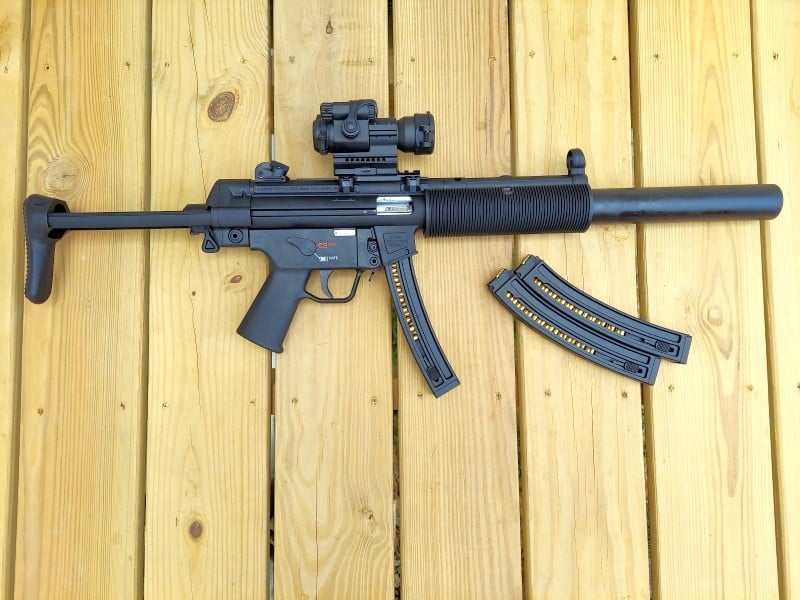
So we have the 16.1-inch barrel. The action operates on the blowback design. Interestingly, the manual states that the bolt’s speed can be adjusted to accommodate various types of ammunition (standard and high velocity).

The trigger is single-stage, and the factory states the pull is between 6.5 and 8.4 pounds. Although on the heavy side, the trigger is decent and fairly crisp.
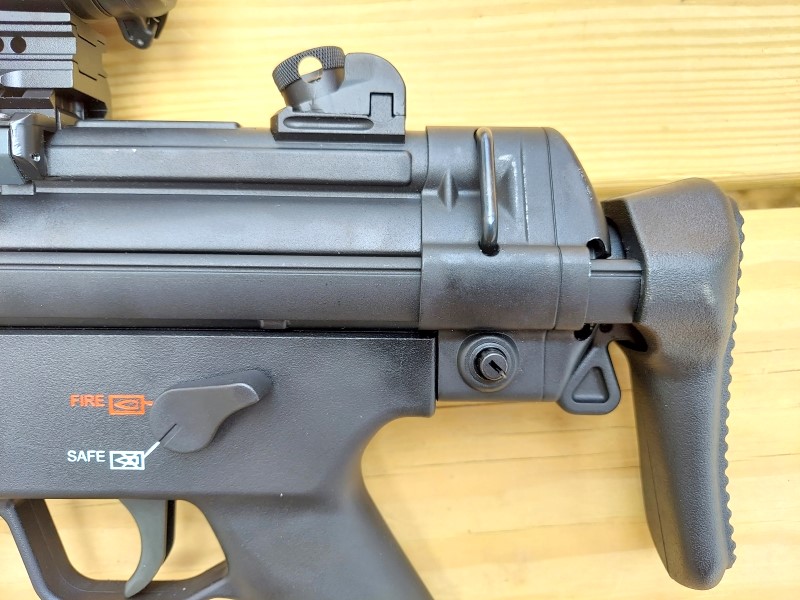
With the stock collapsed, the rifle is 26.8 inches long, and with the stock extended, it is 33.8 inches long. The sight radius is 13.2 inches. While we’re on the subject of the sights, they are extremely authentic, like those that H&K uses. The rear sight is the drum type that can be turned through various ranges. The front sight is a post.


Weight, without the magazine, is 6.7 pounds. Overall, the rifle feels very similar to the real thing. The receiver is all metal, it’s not cheap plastic, so the rifle is solid.
Feeding is accomplished via 10-round and 25-round magazines. Each has tabs on the sides to facilitate easy loading, and they work great.

The charging handle is also very authentic in the best Heckler & Koch style. You can even do the famous “HK Slap,” just like we saw Charlie Sheen in the movie Navy SEALs.

The magazine release is identical to H&K’s, ejecting magazines very efficiently and smoothly. Magazines are ejected via the button on the side or the small lever directly behind the magazine itself; the releases are interchangeable.
I like the telescoping stock, which looks, feels, and operates, as with every other rifle part, just like H&K’s version. With the stock collapsed, the MP-5 is nice and compact.
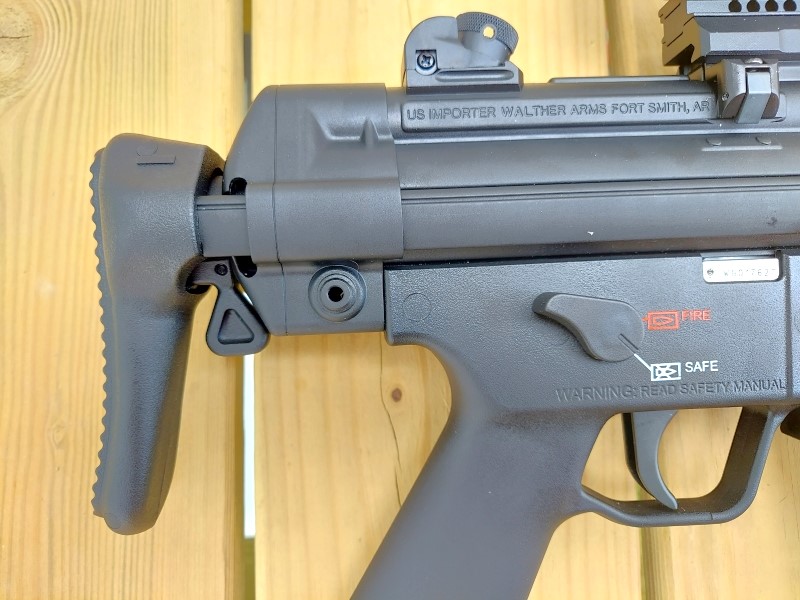
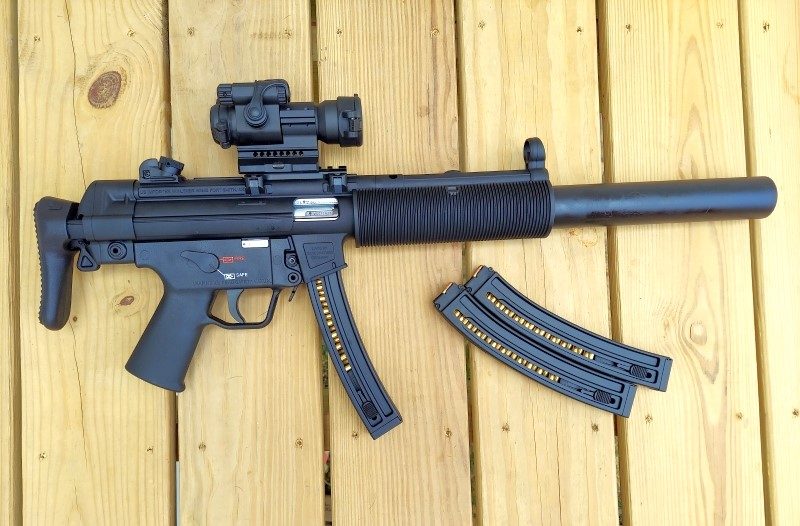
The Walther MP-5 is licensed by Heckler & Koch, and its logo is stamped on the rifle itself. All of the markings appear to be genuine H&K, which adds to the authentic look of this piece.

Cool Factor
Considering that it’s nearly impossible for most of us mere mortals to own a real MP-5, this is a very cool substitute. In fact, if it weren’t for the window in the magazines that allow us to see the rounds in the mags, it would be next to impossible to tell from the outside that this is not an actual MP-5, especially from a couple of feet away.

Even firing the MP-5 sounds similar to the original, given the fact that it mimics a suppressed version. The .22 Long Rifle is not terribly loud, to begin with, especially from a 16-inch barrel. However, if you use subsonic .22LR ammunition, the sonic crack is eliminated, and it sounds even quieter, which mimics the suppressed version of the MP5 SD even more.
MP5 SD6 At The Range
The MP5 SD6 that I’m reviewing is borrowed from a friend. He took the liberty of mounting an Aimpoint red dot optic on it, which makes an already handy firearm even handier. Picking up targets with the red dot is easy and fast.

As expected, recoil is basically non-existent, making rapid-fire easy and fun.
Reliability was 100% with all ammo tested. The rifle digested several different brands of .22LR with no issues.

Groups at 50 yards typically come in around two inches, although we weren’t trying to wring out every last ounce of accuracy in the limited time the gun was available. Bench resting could have squeezed better accuracy out of the rifle. I fired most of the groups rapidly and they were closer to fist size, some even a bit larger than that.
Aside from the fun plinking range factor of this rifle, there is the self-defense aspect. The .22 Long Rifle is not a harmless round, and the 25-round magazines available for this rifle bring it into the realm of a self-defense weapon. Twenty-five rounds are nothing to scoff at and would certainly repel boarders.

At the time of this writing, prices on these vary from just under $400 to around $420. So for what the user gets, it’s a good value. Two thumbs up on this one!


